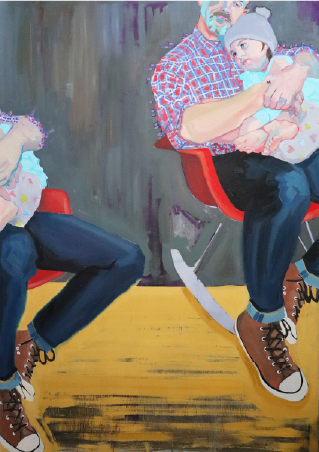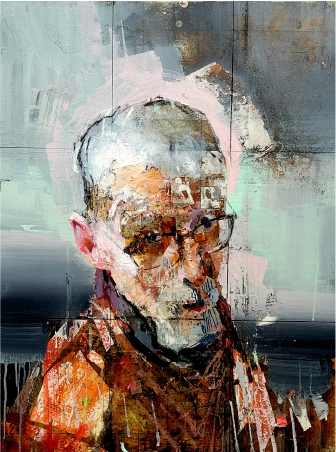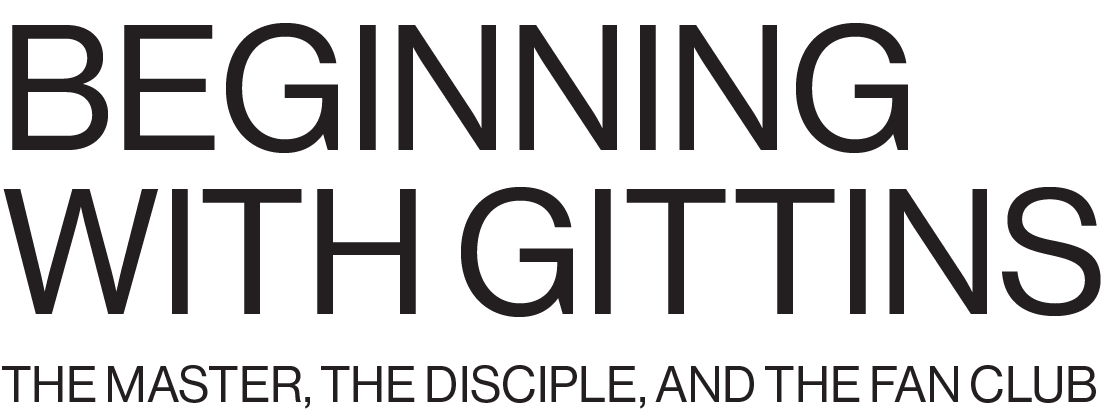A zoom in on a hand in Alvin Gittins' portrait of Theatre’s C. Lowell Lees, which hangs in Pioneer Memorial Theatre foyer (Photo: Hui Zheng)
WRITTEN BY MARINA GOMBERG
One of Hui Zheng’s favorite pieces of art on campus is a portrait of former theatre professor C. Lowell Lees that hangs in the lobby of Pioneer Theatre Company. It’s the brush strokes of the hands that mesmerize him most.
Like so many in our region, painting and drawing student Zheng has a deep reverence and appreciation for the work of former portraitist and University of Utah painting professor Alvin Gittins, whose work featured the likeness of Utah’s ecclesiastic, political, financial, and educational leadership.


Painting by Pam Beach entitled “The Youngest” 36” x 48” (2024); recently on view at the AXA show in New York

Mixed Media work by John Erickson called “Sojourner,” 24”x 32 (2025)
Zheng’s understanding of Gittins’ brilliance has been enlivened by his mentor: Associate Professor, John Erickson, who’s one of Gittins’ self-identified “disciples,” and the person who ultimately helped Zheng define his educational path.
See, this is a story of learning lineage. Of pedagogical pedigree. Of the power one person’s passion and brilliance can have on those skillful enough to absorb it and then spark that fire in another.
Erickson, who has been teaching at the U since 1983, started as a student back in the 1970s and took his first class from Alvin Gittins in 1973.
He described Gittins as a virtuoso and a generous professor — tall and always dressed aristocratically, teaching in a room with only natural light, his cigarette smoke wisping up around him and pluming into the shadow. Given the smorgasbord of modernist art at the time, Erickson gravitated toward Gittins’ masterful realism and ardent understanding of and respect for human anatomy.
“Gittins was a specifist. He taught something anatomically specific and then he bathed that in chiaroscuro [the dramatic use of light and shadow] — which he talked about constantly. Then he brought in the use of color vibration and how that impacted the flesh tones of the figure,” Erickson said. “Learning from Alvin was an ongoing enfoldment of what he knew.”
Like many of Gittins’ devotees, Erickson was less interested in manifesting his own vision at first. For three years, he was fully willing to surrender to absorb Gittins’ “mastery that was magical” before making his own stylistic departure — which, it should be noted, has made Erickson a revered and celebrated painter in his own right.
Painting graduate student Pam Beach, who has worked with Erickson for the last two years, notes that while Erickson doesn’t paint like Gittins, “that strong understanding of anatomical structure is evident.”
She and other current students still benefit from the cadavers and skeletons in the department that Gittins had brought in during his time, along with Erickson’s sharing of form’s importance. And while structural understanding is vital, Beach is guided by Gittins’ quote that “Painting is not to intimate, but to explicate.”
Zheng articulated this same magic in both Erickson’s and Gittins’ works as he communicated the difference between being a “human printer” versus truly seeing and replicating another person’s very essence.
“As a new student, we think we want to draw what’s in front of us really accurately, picture-like,” he said. “That takes technique, but anyone can do it. A good portrait isn’t drawing from reference; it’s drawing from life.”
Zheng says the most important thing he’s learned from Erickson about figurative painting is to balance focus on carpentry (the physical body) and the theatrical (the emotions, psychology, and drama).
Like Gittins, Erickson’s generosity as an educator is deeply appreciated by his mentees. His willingness to spend dedicated time with each student is a proud carryover from what he received from the master himself, who would do demos with each student over the period of a semester, so they walked away with individualized learning and a Gittins work just for them.
To this day, Erickson will take students to any number of Gittins’ works across the University of Utah campus (and there are many), to sit under the work of a great while contemplating the challenges of their current work.
Perhaps unsurprisingly given his prowess and benevolence, Erickson also has a similar following among his scholars. Zheng laughed as he mentioned that among some arts students in the department, they talk about forming a John Erickson fan club complete with t-shirts that say, “John Erickson loves my work.”
And that is the transformative power one educator can have as the ripples of their impact create waves for generations that follow.







